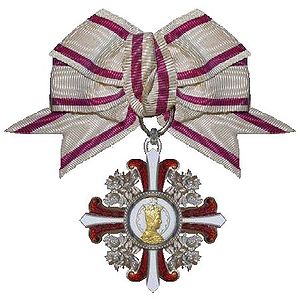
Order of Elizabeth
Encyclopedia

Franz Joseph I of Austria
Franz Joseph I or Francis Joseph I was Emperor of Austria, King of Bohemia, King of Croatia, Apostolic King of Hungary, King of Galicia and Lodomeria and Grand Duke of Cracow from 1848 until his death in 1916.In the December of 1848, Emperor Ferdinand I of Austria abdicated the throne as part of...
, Emperor of Austria
Emperor of Austria
The Emperor of Austria was a hereditary imperial title and position proclaimed in 1804 by the Holy Roman Emperor Francis II, a member of the House of Habsburg-Lorraine, and continually held by him and his heirs until the last emperor relinquished power in 1918. The emperors retained the title of...
and King of Hungary
King of Hungary
The King of Hungary was the head of state of the Kingdom of Hungary from 1000 to 1918.The style of title "Apostolic King" was confirmed by Pope Clement XIII in 1758 and used afterwards by all the Kings of Hungary, so after this date the kings are referred to as "Apostolic King of...
was an order
Order (decoration)
An order or order of merit is a visible honour, awarded by a government, dynastic house or international organization to an individual, usually in recognition of distinguished service to a nation or to humanity. The distinction between orders and decorations is somewhat vague, except that most...
created for women. The Order was the namesake of Saint Elisabeth of Hungary
Elisabeth of Hungary
Elizabeth of Hungary, T.O.S.F., was a princess of the Kingdom of Hungary, Countess of Thuringia, Germany and a greatly-venerated Catholic saint. Elizabeth was married at the age of 14, and widowed at 20. She then became one of the first members of the newly-founded Third Order of St. Francis,...
, but was created to honor and memorialize Franz Joseph's recently slain wife, Empress-Queen Elisabeth
Elisabeth of Bavaria
Elisabeth of Austria was the spouse of Franz Joseph I, and therefore both Empress of Austria and Queen of Hungary. She also held the titles of Queen of Bohemia and Croatia, among others...
.
The order, which only existed until the end of the monarchy in 1918, was divided into three classes: The Grand Cross, first and second classes. There was also an Elizabeth Medal for civil merit.
Significance of Saint Elizabeth
Saint Elisabeth (1207 - 1231) was a Hungarian princess, the daughter of King Andrew II of HungaryAndrew II of Hungary
Andrew II the Jerosolimitan was King of Hungary and Croatia . He was the younger son of King Béla III of Hungary, who invested him with the government of the Principality of Halych...
. Married at age thirteen to Louis IV, Landgrave of Thuringia (ca. 1220), she spent her life giving alms to the poor and sick. After her husband's death, she gave away the vast majority of his estate to build hospitals and to aid in the relief of her starving subjects. After dying of natural causes in 1231, she was canonized by Pope Gregory IX
Pope Gregory IX
Pope Gregory IX, born Ugolino di Conti, was pope from March 19, 1227 to August 22, 1241.The successor of Pope Honorius III , he fully inherited the traditions of Pope Gregory VII and of his uncle Pope Innocent III , and zealously continued their policy of Papal supremacy.-Early life:Ugolino was...
, in 1235. She is considered the patron saint of bakers, beggars, and charities. Given her status as Hungarian royalty, her patronage of charities, and the fact that the Holy Relics attributed to her resided in Vienna, Saint Elizabeth made for a perfect choice for the award's name.
Empress Elizabeth "Sisi"
Nee Duchess Elisabeth of BavariaElisabeth of Bavaria
Elisabeth of Austria was the spouse of Franz Joseph I, and therefore both Empress of Austria and Queen of Hungary. She also held the titles of Queen of Bohemia and Croatia, among others...
(1837 - 1898), "Sisi" was a cousin of King Ludwig II of Bavaria. She married the 24-year old Emperor Francis Joseph in 1854. Despite a cold start to their marriage, the two eventually reconciled, and fell in love. Theirs was a classic, mid-nineteenth century, courtly relationship, where occasional infidelity by one or both parties was discretely accepted. They were, for the most part, "happy" by the standards of the day, and were married for over 44 years. When Elisabeth was assassinated in 1898, the widowed emperor was devastated by the loss. Creating the Order of Elisabeth was as much a public show of affection as his memorial to her as it was to honor Saint Elisabeth.
The Order
According to medal expert and collector Yuri Yashnev:
The award was intended for ladies, regardless of social status or religion, for merits in religious and charitable work. The award had four degrees - the Grand Cross, I Degree and II Degree, and also a cross of merit... Awards were made, personally, by the emperor... the badges and insignia of the Order were to be returned to the state upon the death of the member, or upon the advancement from a lower degree to a higher degree... There were 81 awards of the Grand Cross, 332 awards of the I Degree, 500 awards of the II Degree, and 208 awards of the Elizabeth Medal for merit, between 1898 and 1918, when the Order was disbanded with the collapse of the monarchy.
Sources
- The Catholic Encyclopedia. "St. Elizabeth of Hungary". 1909, On the Internet: http://www.newadvent.org/cathen/05389a.htm
- Yashnev, Yuri. Orders and Medals of the Austro-Hungarian Empire. 2003. On the Internet: http://awards.netdialogue.com/Europe/Austria/AHEmpire/Elizabeth/Elizabeth.htm

